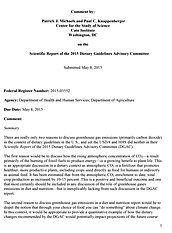The first reason would be to discuss how the rising atmospheric concentration of CO2 — a result primarily of the burning of fossil fuels to produce energy — is a growing benefit to plant life. This is an appropriate discussion in a dietary context as atmospheric CO2 is a fertilizer that promotes healthier, more productive plants, including crops used directly as food for humans or indirectly as animal feed. It has been estimated that from the atmospheric CO2 enrichment to date, total crop production as increased by 10–15 percent. This is a positive and beneficial outcome and one that most certainly should be included in any discussion of the role of greenhouse gases emissions in diet and nutrition — but is inexplicably lacking from such discussion in the DGAC report.
The second reason to discuss greenhouse gas emissions in a diet and nutrition report would be to dispel the notion that through your choice of food you can “do something” about climate change. In this context, it would be appropriate to provide a quantitative example of how the dietary changes recommended by the DGAC would potentially impact projections of the future course
of the climate. Again, the DGAC failed to do this. We help fill this oversight with straightforward calculation of averted global warming that assumes all Americans cut meat out of their diet and become vegetarians — an action that, according to the studies cited by the DGAC, would have the maximum possible impact on reducing greenhouse gas emissions and thus mitigating future climate change. Even assuming such an unlikely occurrence, the amount of global warming that would be averted works out to 0.01°C (one hundredth of a degree) by the end of the 21st century. Such an inconsequential outcome has no tangible implications. This should be expressed by the DGAC and mention of making dietary changes in the name of climate change must be summarily deleted.
We recommend that if the DGAC insists on including a discussion of greenhouse gas emissions (and thus climate change) in it 2015 Dietary Guidelines, that the current discussion be supplemented, or preferably replaced, with a more accurate and applicable one — one that indicates that carbon dioxide has widespread and near-universal positive benefits on the supply of food we eat, and that attempting to limit future climate change through dietary choice is misguided and unproductive. These changes must be made prior to the issuance of the final guidelines.



